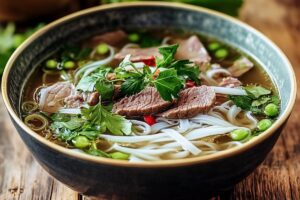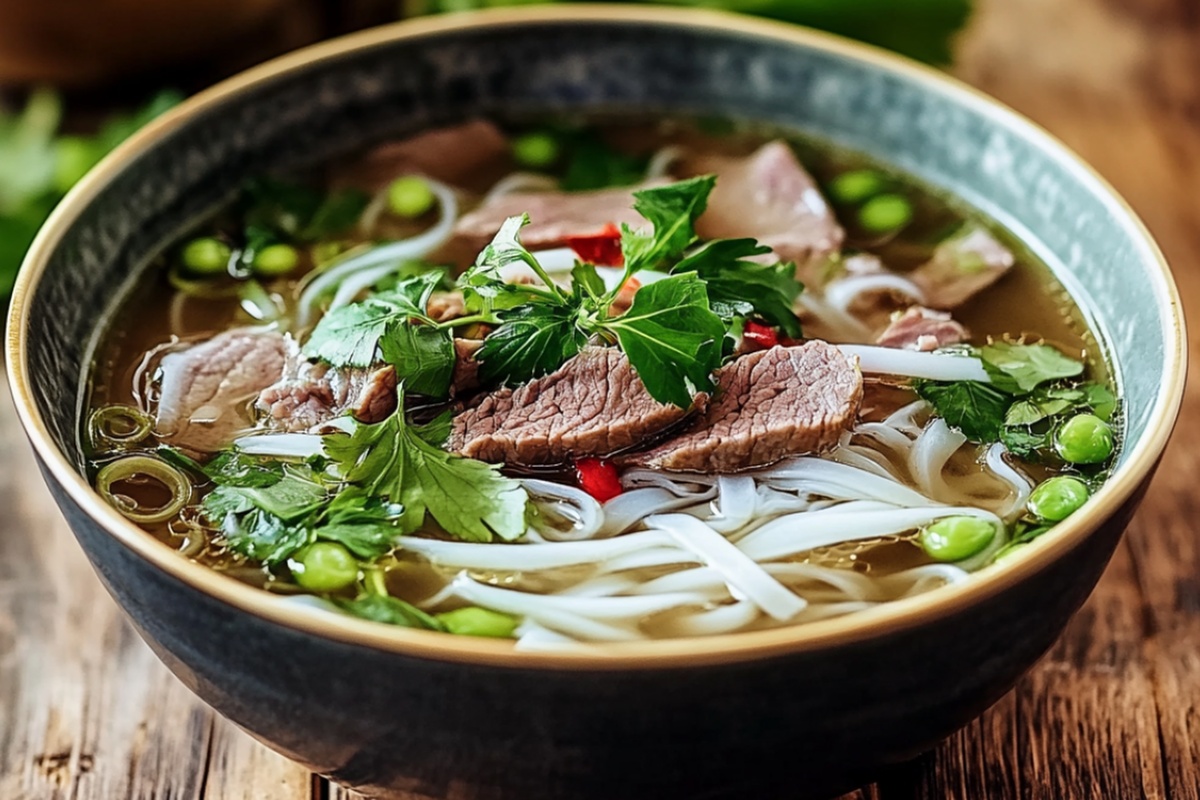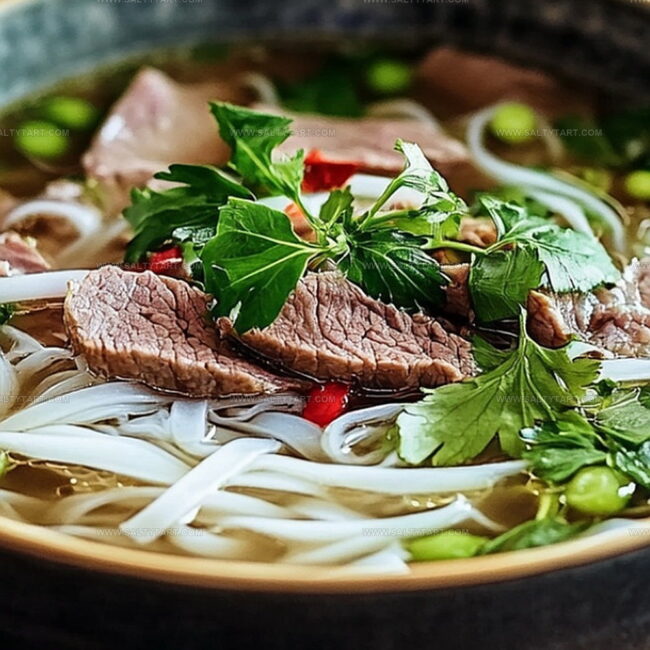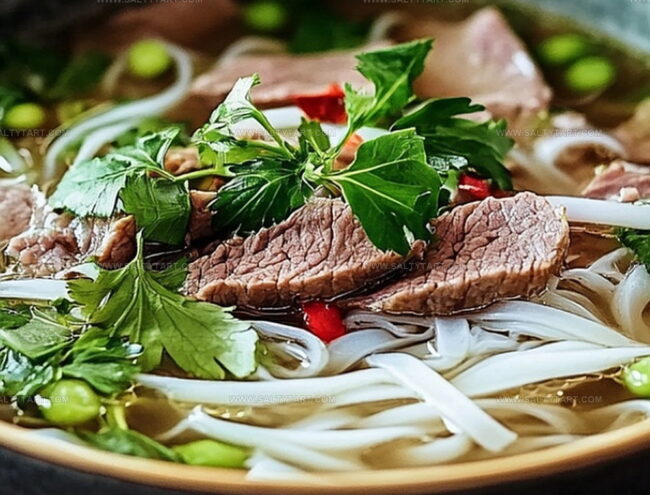The Best Beef Pho Recipe: Cozy Vietnamese Comfort in a Bowl
Steaming bowls of fragrant beef pho have captivated taste buds across continents.
Slurping these delicate noodles transports you straight to the bustling streets of hanoi.
Delightful aromas of star anise and cinnamon weave through tender meat and silky broth.
Vietnamese culinary traditions shine in this soul-warming dish that balances complex flavors with incredible simplicity.
Carefully simmered beef creates a rich, deep foundation that makes each spoonful memorable.
Seasonal herbs and zesty lime add bright, fresh notes to complement the hearty base.
You’ll want to gather ingredients and start cooking right away.
Beef Pho Summary
Ingredients for Beef Pho
Beef Protein:Broth Base:Aromatics and Vegetables:Noodles and Garnishes:How to Prepare Beef Pho
Step 1: Kickstart the Broth Brewing
Fill a large pot with water, leaving room for ingredients. Toss in:Splash in soy sauce or fish sauce to boost the flavor profile.
Step 2: Boil and Beautify the Broth
Crank up the heat and bring the mixture to a rolling boil. Watch for foam bubbling up on the surface.
Grab a spoon and gently skim off the foam to keep the broth crystal clear and super tasty. Let the broth simmer for 1-2 hours, allowing flavors to mingle and deepen.
Top up with water if needed to keep ingredients submerged. Season with salt and pepper as the broth develops.
Step 3: Prep the Noodle Base
While the broth simmers away, cook rice noodles following package directions. Drain thoroughly and set aside.
Step 4: Build Your Pho Masterpiece
Grab a large bowl and create your pho foundation. Layer in:Step 5: Unleash the Liquid Magic
Pour the piping hot broth over the ingredients, letting the beef cook instantly in the steaming liquid.
The heat will transform the raw beef into tender, mouthwatering morsels.
Step 6: Garnish and Devour
Serve immediately with bonus toppings like lime wedges or hoisin sauce.
Dive into your homemade beef pho and savor every single slurp!
Tips for Flavorful Beef Pho
Variations on Beef Pho
Pairing Suggestions for Beef Pho
Storage Advice for Beef Pho
FAQs
Skimming the foam that forms during boiling is crucial. Remove the white foam with a spoon to keep the broth clear and maintain its rich, clean flavor.
Yes, you can use various beef cuts like brisket, chuck, or sirloin depending on your preference. The key is to use thinly sliced beef that will cook quickly in the hot broth.
Pour the hot broth directly over the thinly sliced raw beef in the bowl. The boiling broth will instantly cook the beef, making it tender and safe to eat.
Print
Beef Pho Recipe
- Total Time: 1 hour 50 minutes
- Yield: 6 1x
Description
Simmering Vietnamese Beef Pho brings authentic flavors straight from Hanoi’s bustling streets to home kitchens. Rich broth, tender meat, and aromatic herbs create a soul-warming bowl you’ll crave with every spoonful.
Ingredients
Beef:
- 3 pounds beef neck bones or shank bones
- 1 pound beef fillet or beef shave
Aromatics and Vegetables:
- 2 turnips, sliced into big chunks
- 1 ginger, roasted
- 1 large onion, roasted
- 3 tablespoons (tbsp) soy sauce
- Salt and pepper to taste
Add-ins and Noodles:
- 1 package rice noodles, cooked and drained
- Cilantro
- Basil
- Green onions
- Sliced onions
- Bean sprouts
- Jalapeño
Instructions
- Craft a robust broth by combining beef neck bones, ginger, onion, and turnips in a spacious pot, filling it three-quarters with water and incorporating soy sauce or fish sauce.
- Elevate the liquid to a rolling boil, meticulously removing foam that surfaces to maintain a pristine, clear consistency. Reduce heat and allow the mixture to gently simmer for 1-2 hours, developing profound, complex flavors.
- Periodically replenish water to keep ingredients fully submerged, seasoning with salt and pepper throughout the cooking process to enhance depth and richness.
- Simultaneously prepare rice noodles according to package guidance, ensuring thorough drainage and setting aside while maintaining optimal temperature.
- Strategically arrange cooked noodles in a substantial serving bowl, layering raw beef fillet, fragrant green onions, spicy jalapeños, crisp bean sprouts, delicate onion slices, and aromatic cilantro or basil.
- Carefully cascade the piping hot broth over assembled ingredients, allowing the intense heat to gently cook the beef slices instantaneously.
- Complement the dish with complementary condiments like zesty lime wedges or savory hoisin sauce, presenting a vibrant, authentic Vietnamese culinary experience.
Notes
- Carefully remove and discard any impurities when skimming foam to ensure a crystal-clear, clean-tasting broth that’s rich and flavorful.
- Experiment with different cuts of beef like brisket or oxtail to add more depth and complexity to the traditional pho base.
- Toast whole spices like star anise, cinnamon, and cloves before adding to the broth to enhance their aromatic qualities and create a more robust flavor profile.
- For a lighter version, substitute some beef bones with chicken bones or use lean cuts of meat to reduce overall fat content while maintaining the dish’s signature taste.
- Prep Time: 20 minutes
- Cook Time: 1 hour 30 minutes
- Category: Lunch, Dinner
- Method: Simmering
- Cuisine: Vietnamese
Nutrition
- Serving Size: 6
- Calories: 370 kcal
- Sugar: 3 g
- Sodium: 950 mg
- Fat: 15 g
- Saturated Fat: 5 g
- Unsaturated Fat: 7 g
- Trans Fat: 0.2 g
- Carbohydrates: 30 g
- Fiber: 3 g
- Protein: 35 g
- Cholesterol: 85 mg




Mike Reynolds
Founder & Recipe Developer
Expertise
Farm-to-table cuisine, Seasonal recipe development, Sustainable cooking techniques, Food photography
Education
Asheville-Buncombe Technical Community College (A-B Tech)
Associate Degree in Culinary Arts
Mike studied culinary arts with a strong focus on farm-to-table principles and sustainable cooking. His training emphasized the importance of fresh, local ingredients and environmentally responsible practices in the kitchen.
Mike’s food journey began deep in the Blue Ridge Mountains, where weekends at farmers’ markets and home-cooked meals sparked a lifelong obsession with simple, seasonal eating.
After earning his Associate Degree in Culinary Arts from Asheville-Buncombe Technical Community College, he set out to bring farm-to-table cooking into everyday kitchens, without the fuss.
Mike’s philosophy is all about keeping it fresh, unfussy, and full of heart. When he’s not crafting new single-serving recipes, he’s hiking mountain trails, chatting with local farmers, or experimenting with wild ingredients in his backyard kitchen.